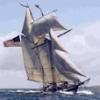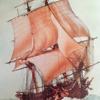MORE HANDBOOKS ARE ON THEIR WAY! We will let you know when they get here.
×
-
Posts
629 -
Joined
-
Last visited
Reputation Activity
-
 kruginmi got a reaction from Kevin in HMS Druid by Krug - FINISHED - 1:48 - Hahn
kruginmi got a reaction from Kevin in HMS Druid by Krug - FINISHED - 1:48 - Hahn
Thanks for all the looks, likes and comments! I am starting to feel a bit of disbelief that this build is coming to a conclusion (not without continuous challenges and hurdles to overcome).
Forged ahead to the quarterdeck extension:
LOTS of lessons learned here (hah, hah):
1. Always be aware of part orientation (which side is forward, which is back). This is particularly true when cutting mortises for rail columns. Luckily not a huge issue since the aft side is hidden on the deck beam.
2. Always be aware of whether or not your measurements include or not include the floor planking. That can sure ruin a lot of hand carved rail columns if they are cut too short.
Sometimes you get the bear, sometimes the bear gets you. I was able to work through my Mark made issues and eventually persevere.
When I had originally completed the quarterdeck extension I planked the whole section solid. Standing back and looking at the result the little voice in my head (cause of so much additional work) clearly stated it just didn't go with the rest of the build and had to be modified. I went back and cut the view ports in. It does look a lot better.
The capstan is still entirely removable.
I did think of a issue to think through though:
I have decided to add the capstan bars to the capstan on the quarterdeck. The radius of the bars is somewhat evident and extends almost to the ships wheel. The problem is the binnacle. Its location puts it right in the middle of the capstan bar space. I am thinking that the binnacle was removable when required. Looking at the Hahn photos he did not include a binnacle (nor is one shown on the plans). I am starting to think to add tie down points for the binnacle but not include the actual one. Any thoughts?
Stay Building My Friends,
mark
-
 kruginmi got a reaction from Kevin in HMS Druid by Krug - FINISHED - 1:48 - Hahn
kruginmi got a reaction from Kevin in HMS Druid by Krug - FINISHED - 1:48 - Hahn
I finished the original quarterdeck planking. Now I am moving on to the extension built on by the British. This is complicated by needing to build the deck railing between it and the gun deck prior to the planking.
The British added this so that the required capstan addition was usable. That this wasn't originally planned for the ship will be seen with the resultant cut away cap railing and exposed section of the extension where the ladders will be. The railing will still end at its normal place and that was a head scratcher for me for awhile before I remembered the ratlines / shrouds for the main mast occupy this space and provide the same function (perils of not thinking about a fully rigged ship!).
Stay Building My Friends,
Mark
-
 kruginmi reacted to mtaylor in HMS Druid by Krug - FINISHED - 1:48 - Hahn
kruginmi reacted to mtaylor in HMS Druid by Krug - FINISHED - 1:48 - Hahn
Mark,
Binnacles were removable. I think that part of the "clear for action" included removing it. You wouldn't want your navigation equipment shot up.
-
 kruginmi got a reaction from mtaylor in What do you think of this method of planking?
kruginmi got a reaction from mtaylor in What do you think of this method of planking?
I guess the question is does the builder have a plan about how the planks will lay across the whole hull. It looks like they are getting some close line up of the plank ends which isn't optimal. I would guess they are doing single planking (double planking it wouldn't matter at all) and are really focused on the joinery at the bow and stern.
It could turn out fine, my gut just says it would be harder making sure everything lines up from bow to stern. I don't think I will be going in this direction.
Mark
-
 kruginmi got a reaction from Mirabell61 in HMS Druid by Krug - FINISHED - 1:48 - Hahn
kruginmi got a reaction from Mirabell61 in HMS Druid by Krug - FINISHED - 1:48 - Hahn
I finished the original quarterdeck planking. Now I am moving on to the extension built on by the British. This is complicated by needing to build the deck railing between it and the gun deck prior to the planking.
The British added this so that the required capstan addition was usable. That this wasn't originally planned for the ship will be seen with the resultant cut away cap railing and exposed section of the extension where the ladders will be. The railing will still end at its normal place and that was a head scratcher for me for awhile before I remembered the ratlines / shrouds for the main mast occupy this space and provide the same function (perils of not thinking about a fully rigged ship!).
Stay Building My Friends,
Mark
-
 kruginmi got a reaction from Aussie048 in HMS Druid by Krug - FINISHED - 1:48 - Hahn
kruginmi got a reaction from Aussie048 in HMS Druid by Krug - FINISHED - 1:48 - Hahn
I finished the original quarterdeck planking. Now I am moving on to the extension built on by the British. This is complicated by needing to build the deck railing between it and the gun deck prior to the planking.
The British added this so that the required capstan addition was usable. That this wasn't originally planned for the ship will be seen with the resultant cut away cap railing and exposed section of the extension where the ladders will be. The railing will still end at its normal place and that was a head scratcher for me for awhile before I remembered the ratlines / shrouds for the main mast occupy this space and provide the same function (perils of not thinking about a fully rigged ship!).
Stay Building My Friends,
Mark
-
 kruginmi got a reaction from Elmer Cornish in HMS Druid by Krug - FINISHED - 1:48 - Hahn
kruginmi got a reaction from Elmer Cornish in HMS Druid by Krug - FINISHED - 1:48 - Hahn
I finished the original quarterdeck planking. Now I am moving on to the extension built on by the British. This is complicated by needing to build the deck railing between it and the gun deck prior to the planking.
The British added this so that the required capstan addition was usable. That this wasn't originally planned for the ship will be seen with the resultant cut away cap railing and exposed section of the extension where the ladders will be. The railing will still end at its normal place and that was a head scratcher for me for awhile before I remembered the ratlines / shrouds for the main mast occupy this space and provide the same function (perils of not thinking about a fully rigged ship!).
Stay Building My Friends,
Mark
-
 kruginmi got a reaction from Kevin in HMS Druid by Krug - FINISHED - 1:48 - Hahn
kruginmi got a reaction from Kevin in HMS Druid by Krug - FINISHED - 1:48 - Hahn
Still working away when the time is available. I continued with the lower capstan (very limited viewing) to try out some techniques and am pretty happy with the result. I do have some build improvements for the upper one. I still have the bar partitions to construct. The idea has popped into my head to install the bars in the upper capstan on the finished model. The quarterdeck is a little 'empty' and I am thinking why not. Of course, more time required to this already lengthy build but who is counting.....
I had a bit of an a-ha moment when I realized I did not need to finish these things prior to getting the quarterdeck planked, in fact it would be preferred not to have them in the way. The important item was to have the raised platform for them roughed in. Until I glue this platform in, I could take the assembly on and off. So, on to the (last) bit of major planking on this ship.
I have settled on the lower half as the completed look I was looking for. This was a bit of free style work. What gap to keep is totally up to the builder. Most that I have seen of this type is much smaller, but I wanted to have as good as possible look at the partitions and captain's cabin below (not to mention to even have a chance at the orlop deck work I did). The plank divisions will pop when I gel coat this.
Still quite a few things on the list, but it is dwindling.
Stay Building My Friends,
Mark
-
 kruginmi got a reaction from WackoWolf in HMS Druid by Krug - FINISHED - 1:48 - Hahn
kruginmi got a reaction from WackoWolf in HMS Druid by Krug - FINISHED - 1:48 - Hahn
I finished the original quarterdeck planking. Now I am moving on to the extension built on by the British. This is complicated by needing to build the deck railing between it and the gun deck prior to the planking.
The British added this so that the required capstan addition was usable. That this wasn't originally planned for the ship will be seen with the resultant cut away cap railing and exposed section of the extension where the ladders will be. The railing will still end at its normal place and that was a head scratcher for me for awhile before I remembered the ratlines / shrouds for the main mast occupy this space and provide the same function (perils of not thinking about a fully rigged ship!).
Stay Building My Friends,
Mark
-
 kruginmi got a reaction from Kevin in HMS Druid by Krug - FINISHED - 1:48 - Hahn
kruginmi got a reaction from Kevin in HMS Druid by Krug - FINISHED - 1:48 - Hahn
Slowly plugging away at the rudder as time allows. With the silver soldering finally set right I can move forward. The metal work still requires the nail holes drilled and then blackened but I am happy with them.
After soldering the three pieces together it took about an hour to slowly bend and fashion it to the correct profile. After I was satisfied (and the length was cut to its required length) I did mark its profile and chisel it in. As is seen in the pictures, the pieces stay put rather well even before glue and nails. I want to have the rudder work totally done and rock solid before I start the hull side to keep the variables to a minimum.
Still have a rear wood piece on the rudder and then eventually the tiller arm. My goal is to have the rudder basically done by the end of the weekend.
mark
-
 kruginmi got a reaction from albert in HMS Druid by Krug - FINISHED - 1:48 - Hahn
kruginmi got a reaction from albert in HMS Druid by Krug - FINISHED - 1:48 - Hahn
On to the chesstrees. There is definitely a few hours here as will be explained below. My first gut was to jump right in, make a cardboard template to match the hull shape, transfer to a wooden piece and get'r done. Well, I never really like butt joints that show and in this case I was unable to get a real tight fit all around the chesstree. Pause to think.....
Well, the easiest way is to inset the chesstree into the planking. So, I carefully trace around the chesstree and chisel half a plank depth away.
The result is much more satisfying. As a bonus, the joint will be a whole lot stronger.
Now here came the biggest problem to overcome, creating the sheave hole. At first I jumped in and carefully drilled a hole at both ends of the sheave hole and tried to remove any remaining wood in between. I didn't even take a picture as the result was totally unacceptable no matter how much I carefully filed, scraped and poked. I ended up walking away for the night.
Later on the solution came to me and involved keeping it as simple as possible. I would cut into the chesstree to the sheave from the bottom. Once everything was cleaned up (now that the entire hole was accessible this was easy), a small section of wood would be replaced. Very quick and the result I liked very much. The actual block you see is one fashioned quickly and will be replaced.
So overall the process was probably 3.5 hours. The next one for the port side will probably be done in less than half the time but I am okay with that. I ended up with something that looks good and methodically worked through the issues as they came up.
Cheers,
Mark
-
 kruginmi got a reaction from VonHoldinghausen in HMS Druid by Krug - FINISHED - 1:48 - Hahn
kruginmi got a reaction from VonHoldinghausen in HMS Druid by Krug - FINISHED - 1:48 - Hahn
Let's see. Banging headache (hoping it didn't go into a migraine). I did
something to my heel and it hurt to walk. Too many things to do around the
house. So....best just go to the workshop. It was the right cure because a
couple of hours later and I am feeling better (head wise) and I am reflecting on
completing the entry steps (starboard side at least).
Those items had been a little intimidating - why? I don't know. I stumbled
across some 1/32nd inch cutoff discs for my dremel (so much easier than the
1/16th inch), drew up a simple molding pattern and had it quickly cut out. I
actually found a previously cut piece of boxwood that matched the dimensions
required. Some quick scraping and cutting to equal lengths and I was ready to
glue.
I laid down some paint tape to get a straight line and cut out a spacer to
insure they match. The big question was whether the eighth step would rest on
the wales as the plans show....and yes it did.
This almost was too easy. What did I forget or mess up? Still haven't figured
it out yet (hah, hah). Pics are posted. I do laugh to see how the camera
really seems to magnify all the issues, dents and everything wrong that are
invisible otherwise.
One almost oops moment was when I as verifying the distance from the steps to the end of the waist railing - it was too short. A couple of anxious moments before I realized (so many years ago) that I had intentionally left the upper railing long to allow cutting down in the future. So, no issues. Tonight I hope to get the port side done. This will officially end the external hull work (sans the eking rail which waits until the cathead is affixed). The rudder metal work awaits.
Mark
-
 kruginmi reacted to dgbot in HMS Druid by Krug - FINISHED - 1:48 - Hahn
kruginmi reacted to dgbot in HMS Druid by Krug - FINISHED - 1:48 - Hahn
Your Druid is really coming along Mark. You must bring to Manitowoc next year. We always get modelers from MI every year and they all have a good time. You would really give a big WOW factor to the show.
David B
-
 kruginmi reacted to cpt. Tom in HMS Druid by Krug - FINISHED - 1:48 - Hahn
kruginmi reacted to cpt. Tom in HMS Druid by Krug - FINISHED - 1:48 - Hahn
You doing a very fantastic work Mark, very nicely built and all the details......great, absolutely great
-
 kruginmi reacted to dvm27 in HMS Druid by Krug - FINISHED - 1:48 - Hahn
kruginmi reacted to dvm27 in HMS Druid by Krug - FINISHED - 1:48 - Hahn
She's looking beautiful, Mark. I wonder how she sailed? She's a bit of a tub with that bluff bow. Not surprising since she was a converted mercantile ship.
-
 kruginmi got a reaction from mtaylor in HMS Druid by Krug - FINISHED - 1:48 - Hahn
kruginmi got a reaction from mtaylor in HMS Druid by Krug - FINISHED - 1:48 - Hahn
I finished the original quarterdeck planking. Now I am moving on to the extension built on by the British. This is complicated by needing to build the deck railing between it and the gun deck prior to the planking.
The British added this so that the required capstan addition was usable. That this wasn't originally planned for the ship will be seen with the resultant cut away cap railing and exposed section of the extension where the ladders will be. The railing will still end at its normal place and that was a head scratcher for me for awhile before I remembered the ratlines / shrouds for the main mast occupy this space and provide the same function (perils of not thinking about a fully rigged ship!).
Stay Building My Friends,
Mark
-
 kruginmi got a reaction from Kevin in HMS Druid by Krug - FINISHED - 1:48 - Hahn
kruginmi got a reaction from Kevin in HMS Druid by Krug - FINISHED - 1:48 - Hahn
Continuing to hammer away at the forecastle as time allows. The floor planking is complete and this evening I pretty much got the cap rails. They are not glued as of yet:
This leaves the tie down posts which affix to the cap rails, cleats, 2 ladders, blackening of the chimney and the eking rails. Oh - the scroll transition piece from upper to lower railing. The list continually shrinks. I am amazed at how much the look of the ship has changed in the last couple of weeks.
Tracing the exposed deck beam onto some paper was VERY key to making the deck plank cover up board quite easy. It does not cover up the entire deck beam to give some more grip / glue area to the ladders.
My plan for the tie down posts is, once their locations are known, to drill a hole for a dowel through the cap rail. Then the tie down post will be tack glued above this hole. Once set, I will drill from the bottom and then insert the dowel. Less things to juggle and should insure an accurate fit.
Stay Building My Friends,
Mark
-
 kruginmi got a reaction from JesseLee in HMS Druid by Krug - FINISHED - 1:48 - Hahn
kruginmi got a reaction from JesseLee in HMS Druid by Krug - FINISHED - 1:48 - Hahn
I finished the original quarterdeck planking. Now I am moving on to the extension built on by the British. This is complicated by needing to build the deck railing between it and the gun deck prior to the planking.
The British added this so that the required capstan addition was usable. That this wasn't originally planned for the ship will be seen with the resultant cut away cap railing and exposed section of the extension where the ladders will be. The railing will still end at its normal place and that was a head scratcher for me for awhile before I remembered the ratlines / shrouds for the main mast occupy this space and provide the same function (perils of not thinking about a fully rigged ship!).
Stay Building My Friends,
Mark
-
 kruginmi got a reaction from cpt. Tom in HMS Druid by Krug - FINISHED - 1:48 - Hahn
kruginmi got a reaction from cpt. Tom in HMS Druid by Krug - FINISHED - 1:48 - Hahn
I finished the original quarterdeck planking. Now I am moving on to the extension built on by the British. This is complicated by needing to build the deck railing between it and the gun deck prior to the planking.
The British added this so that the required capstan addition was usable. That this wasn't originally planned for the ship will be seen with the resultant cut away cap railing and exposed section of the extension where the ladders will be. The railing will still end at its normal place and that was a head scratcher for me for awhile before I remembered the ratlines / shrouds for the main mast occupy this space and provide the same function (perils of not thinking about a fully rigged ship!).
Stay Building My Friends,
Mark
-
 kruginmi got a reaction from JesseLee in HMS Druid by Krug - FINISHED - 1:48 - Hahn
kruginmi got a reaction from JesseLee in HMS Druid by Krug - FINISHED - 1:48 - Hahn
Still working away when the time is available. I continued with the lower capstan (very limited viewing) to try out some techniques and am pretty happy with the result. I do have some build improvements for the upper one. I still have the bar partitions to construct. The idea has popped into my head to install the bars in the upper capstan on the finished model. The quarterdeck is a little 'empty' and I am thinking why not. Of course, more time required to this already lengthy build but who is counting.....
I had a bit of an a-ha moment when I realized I did not need to finish these things prior to getting the quarterdeck planked, in fact it would be preferred not to have them in the way. The important item was to have the raised platform for them roughed in. Until I glue this platform in, I could take the assembly on and off. So, on to the (last) bit of major planking on this ship.
I have settled on the lower half as the completed look I was looking for. This was a bit of free style work. What gap to keep is totally up to the builder. Most that I have seen of this type is much smaller, but I wanted to have as good as possible look at the partitions and captain's cabin below (not to mention to even have a chance at the orlop deck work I did). The plank divisions will pop when I gel coat this.
Still quite a few things on the list, but it is dwindling.
Stay Building My Friends,
Mark
-
 kruginmi got a reaction from WackoWolf in HMS Druid by Krug - FINISHED - 1:48 - Hahn
kruginmi got a reaction from WackoWolf in HMS Druid by Krug - FINISHED - 1:48 - Hahn
Still working away when the time is available. I continued with the lower capstan (very limited viewing) to try out some techniques and am pretty happy with the result. I do have some build improvements for the upper one. I still have the bar partitions to construct. The idea has popped into my head to install the bars in the upper capstan on the finished model. The quarterdeck is a little 'empty' and I am thinking why not. Of course, more time required to this already lengthy build but who is counting.....
I had a bit of an a-ha moment when I realized I did not need to finish these things prior to getting the quarterdeck planked, in fact it would be preferred not to have them in the way. The important item was to have the raised platform for them roughed in. Until I glue this platform in, I could take the assembly on and off. So, on to the (last) bit of major planking on this ship.
I have settled on the lower half as the completed look I was looking for. This was a bit of free style work. What gap to keep is totally up to the builder. Most that I have seen of this type is much smaller, but I wanted to have as good as possible look at the partitions and captain's cabin below (not to mention to even have a chance at the orlop deck work I did). The plank divisions will pop when I gel coat this.
Still quite a few things on the list, but it is dwindling.
Stay Building My Friends,
Mark
-

-
 kruginmi got a reaction from egkb in HMS Druid by Krug - FINISHED - 1:48 - Hahn
kruginmi got a reaction from egkb in HMS Druid by Krug - FINISHED - 1:48 - Hahn
No problem Eamonn, Seems like forever but it was back on page 2 of this build:
General Finishes
Gel Topcoat
Wipe on Urethane
Satin
Those top rails are the big builds left (forgetting the figure head for the moment). Everything has a plan, just need to execute. Maybe end of June.
Mark
-
 kruginmi got a reaction from mtaylor in HMS Druid by Krug - FINISHED - 1:48 - Hahn
kruginmi got a reaction from mtaylor in HMS Druid by Krug - FINISHED - 1:48 - Hahn
Still working away when the time is available. I continued with the lower capstan (very limited viewing) to try out some techniques and am pretty happy with the result. I do have some build improvements for the upper one. I still have the bar partitions to construct. The idea has popped into my head to install the bars in the upper capstan on the finished model. The quarterdeck is a little 'empty' and I am thinking why not. Of course, more time required to this already lengthy build but who is counting.....
I had a bit of an a-ha moment when I realized I did not need to finish these things prior to getting the quarterdeck planked, in fact it would be preferred not to have them in the way. The important item was to have the raised platform for them roughed in. Until I glue this platform in, I could take the assembly on and off. So, on to the (last) bit of major planking on this ship.
I have settled on the lower half as the completed look I was looking for. This was a bit of free style work. What gap to keep is totally up to the builder. Most that I have seen of this type is much smaller, but I wanted to have as good as possible look at the partitions and captain's cabin below (not to mention to even have a chance at the orlop deck work I did). The plank divisions will pop when I gel coat this.
Still quite a few things on the list, but it is dwindling.
Stay Building My Friends,
Mark
-
 kruginmi got a reaction from egkb in HMS Druid by Krug - FINISHED - 1:48 - Hahn
kruginmi got a reaction from egkb in HMS Druid by Krug - FINISHED - 1:48 - Hahn
Still working away when the time is available. I continued with the lower capstan (very limited viewing) to try out some techniques and am pretty happy with the result. I do have some build improvements for the upper one. I still have the bar partitions to construct. The idea has popped into my head to install the bars in the upper capstan on the finished model. The quarterdeck is a little 'empty' and I am thinking why not. Of course, more time required to this already lengthy build but who is counting.....
I had a bit of an a-ha moment when I realized I did not need to finish these things prior to getting the quarterdeck planked, in fact it would be preferred not to have them in the way. The important item was to have the raised platform for them roughed in. Until I glue this platform in, I could take the assembly on and off. So, on to the (last) bit of major planking on this ship.
I have settled on the lower half as the completed look I was looking for. This was a bit of free style work. What gap to keep is totally up to the builder. Most that I have seen of this type is much smaller, but I wanted to have as good as possible look at the partitions and captain's cabin below (not to mention to even have a chance at the orlop deck work I did). The plank divisions will pop when I gel coat this.
Still quite a few things on the list, but it is dwindling.
Stay Building My Friends,
Mark












